
Mountain mints (Pycnanthemum spp.) are clump-forming native perennials. They typically grow 1-3 feet tall depending on species (USDA hardiness zones 4 – 8). About 20 species of mountain mints are found in the southeastern U.S. As their name suggests, they belong to the mint family, very evident by their square stems and aromatic leaves when crushed. Botanically, they’re also closely related to beebalms (Monarda). Mountain mints grow in open woodlands, dry prairies, and grassy meadows.
Mountain mints are rhizomatous perennials that grow 2 to 3 feet tall and spread as wide as site conditions allow. Their slender upright stems have oppositely arranged leaves that are either broadly lanceolate in form or narrow and willow-like in appearance.
Only two mountain mint species will be highlighted here. Slender mountain mint (P. tenuifolium), also called common horsemint or Virginia thyme, is easily identified by its narrow, almost needle-like foliage and are covered with small ¼ inch white tubular flowers with purple anthers in mid-summer (in Tennessee).
Number two is short-tooth mountain mint (P. muticum) which grows slightly more compact and its growth rate is more aggressive. Its foliage is very different and more lustrous, 1-3 inch long, broader (½ -1 inch across) and pointed leaf tips. Clusters of tiny tubular white to pinkish flowers appear in mid-summer. Flowers are accompanied with showy frosted (silvery) bracts.
Blooming period lasts 4-6 weeks, from early to mid-summer. Leaves emit a mild mint fragrance and flowers are not fragrant. Slender mountain mint is highly rated by the Xerces Society, with designated “Special Value” to Native Bees, Bumblebees, and Honey Bees. Flowers of mountain mints attract a wide range of insects including many kinds of bees and butterflies.
For best flowering, mountain mints should be grown in full sun, but do tolerate light shade. Slender mountain mint is rated as more drought tolerant. No serious insect or disease problems trouble the mountain mints. Foliar rust disease may occur in wet summers.
Easily grown from seed, these two species can be started indoors in late winter. OR, sow seeds outdoors after the threat of frost has past in your area; plants should be well established by the end of their first growing season. Established plants have a taproot and spread via rhizomes. Control their spread by mowing or trimming. Mountain mints are easily propagated by cuttings and clump division.
Mountain mints naturalize freely in native plant gardens, butterfly gardens or meadows, garden borders. The foliage is a natural mosquito repellent; the minty leaves can be added to teas.

 Posted in
Posted in 
